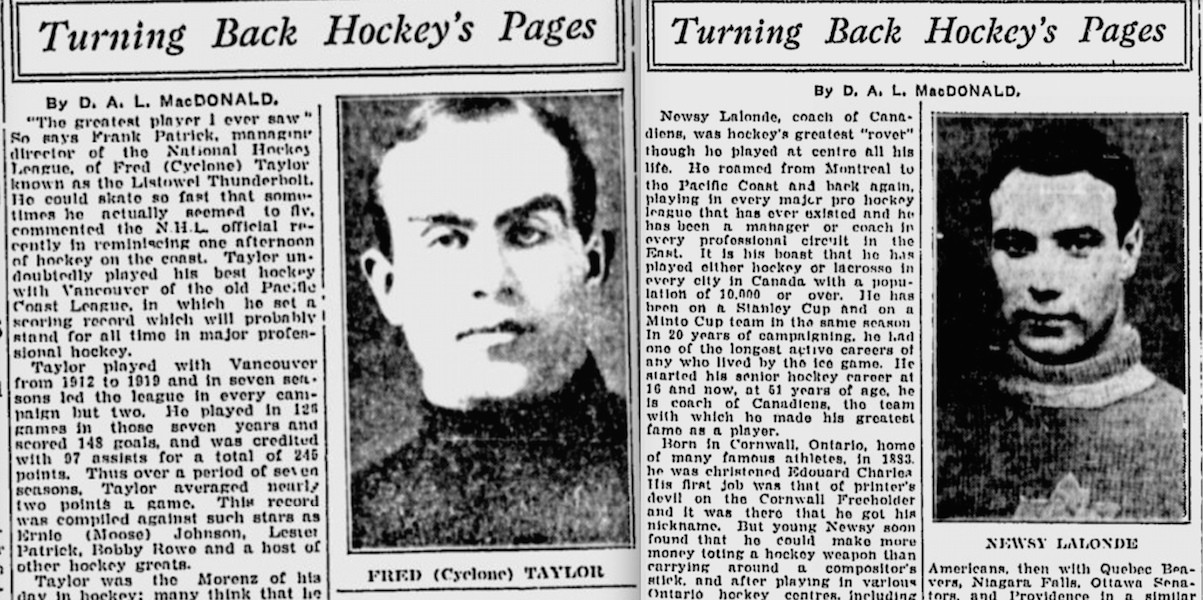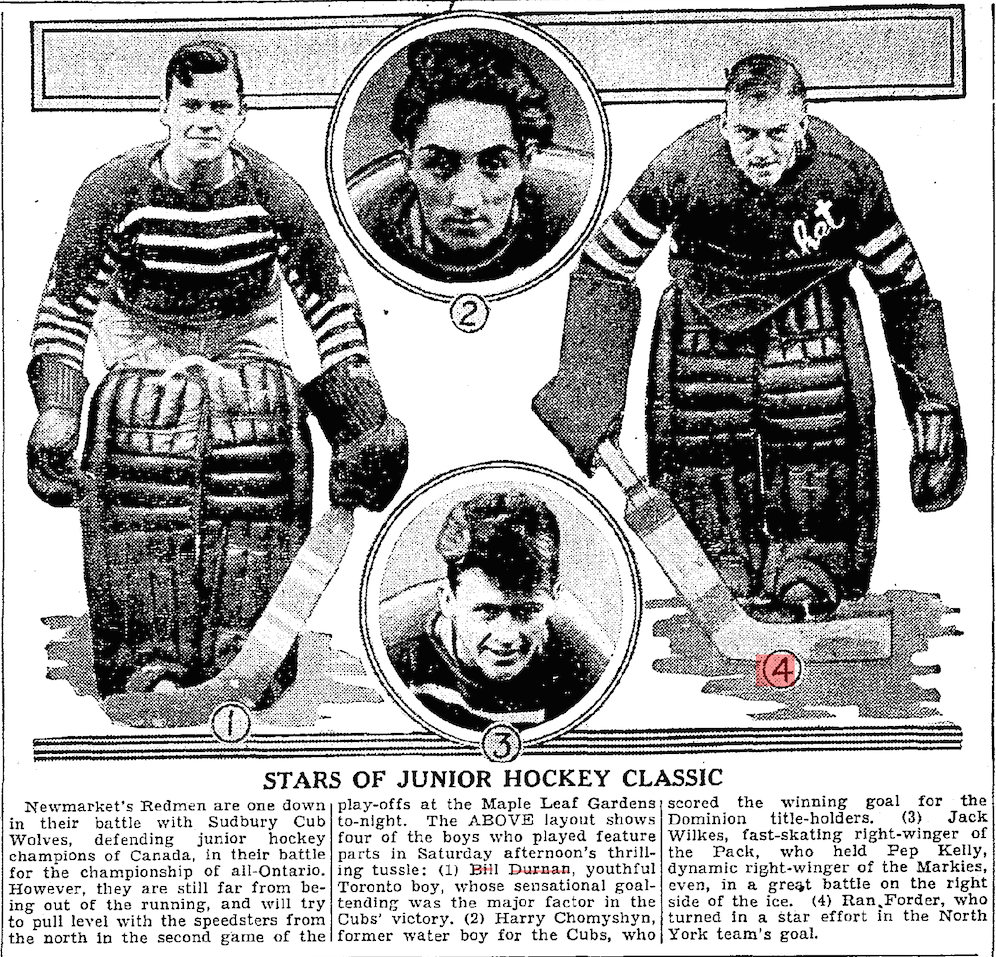After my first experience on the internet, I remember thinking, “this is all pretty good, but until I can sit at my desk at home and read through old newspapers, what’s the big deal?”
There once was a time (not all that long ago, really) when the only way you could research old papers was to visit a library and scroll through microfilm. I still do that when I have to, but it probably won’t surprise you to learn that I now spend an awful lot of my time reading old newspapers online.

Cyclone’s story appeared in the Montreal Gazette
on January 2, 1934. Newsy’s appeared on February 1, 1934.
While old newspapers can’t answer every question, it seems to me that too many old-time sportswriters didn’t consider any research beyond their own memory to be worth the effort. When we at Dan Diamond & Associates began working on the first edition of Total Hockey in 1997, it was amazing to me to see how often the statistics (mainly compiled from old newspapers on microfilm by Ernie Fitzsimmons) didn’t match up to the stories that had always been told.
I don’t know why this particular bit has stuck in my mind for nearly 20 years, but it has. Written accounts for legendary Montreal Canadiens goaltender Bill Durnan had always said something along the lines of, “he first came to prominence with the Sudbury juniors in the OHA finals of 1934…” Yet the stats now showed that Durnan had actually played in Sudbury the year before. (The text in the Durnan bio was corrected in the second edition of Total Hockey.)
Today, with a few clicks and some clever search terms, there’s Durnan (apparently already wearing his ambidextrous gloves!) tending goal for Sudbury against Newmarket during the Ontario junior finals of 1933.

Bill Durnan and company appeared in the Toronto Star on March 20, 1933.
In the great scheme of things, does it really matter where and when some old hockey player played? Well, think of it this way. What if we were still this sloppy about political history, or military history … or current sports reporting? That’s why there are plenty of us out there trying to get these old facts right.
There’s a line in a classic movie that goes, “When the legend becomes fact, print the legend.” For a long time, that was all anyone bothered to do. But that shouldn’t be good enough anymore!
To the best of my knowledge, the first big effort to really tell the stories of old-time hockey began 83 years ago yesterday, on January 2, 1934, when D.A.L. MacDonald printed the first of his series, Turning Back Hockey’s Pages, in the Montreal Gazette. On Tuesdays, Thursdays and Saturdays (occasionally on other days of the week too) during the 1933-34 and 1934-35 seasons, a total of 84 articles appeared. Most were on old-time hockey stars, some were about early teams, and at least one was about the Hod Stuart Memorial Game (which I’ve mentioned in these pages before). The stories cover players from the 1880s through the 1920s. Many of them are still big names in hockey history; others are long-forgotten.
I haven’t yet read them all, but, generally speaking, the stories are fantastic. MacDonald had clearly gone through years of back issues of the Gazette, and yet even his sincere effort to do more than just print the legends is filled with all sorts of little errors. Wrong dates, wrong team names. That sort of thing. In the feature on Cyclone Taylor, for instance, it mentions him playing with “Portland Lakes” when the team was actually Portage Lakes. Not the worst of errors, admittedly, but an error nonetheless. And there are lots of others like them.

Gordie Roberts was featured on January 25, 1934; Jack Marshall on February 13.
Of the pieces I’ve read, the only one where it appears that MacDonald actually had input from the player being featured is the story on February 13, 1934, about future Hall of Famer Jack Marshall. His career at the game’s highest level had stretched from 1898 to 1917, and his take on the then current game rings familiar today.
“They talk about the dearth of goals nowadays,” says Marshall. “No wonder. Look at the goaltenders padded up like stuff pigeons. Do you know why goaltenders first wore pads? It was for personal protection. And do you think a ten-inch pad on either leg is absolutely necessary for protection?”
“That,” writes MacDonald, “is his answer to what is the matter with present day hockey.”
Jack Marshall lived until 1965. Long enough to see Bobby Hull and his slap shot; Jacques Plante and his mask. I wonder if he ever changed his mind? Then again, just the other day at the Centennial Classic, when he was named one of the 100 greatest players of all time, Hall of Fame goalie Glenn Hall said: “Today’s goalkeepers are great, and you get some skinny little fella and he’s got on pants that are 10 times too large.”
But as I’ve pointed out here before, the question of how much protection for goalies is too much is one that people have been asking for a very long time!
I have to read Turning Back the Pages! Dr. Gordie Roberts–who knew? I need the rest of the story. . .
Another well-written piece Eric. Please keep up the great work, I really enjoy reading your posts.
“Print the legend” – a great line from “The Man Who Shot Liberty Valance,” which in turn is a tremendous film!
Yeah, “…Liberty Valance…” (1962) is the one people know the line from. Similar sentiments were expressed in the final scene of Ford’s “Fort Apache” in 1948.
Eric, as always, I admire the research you do. Fascinating information.
Eric, do you have a listing of all the players he covered in this series? Roger
Unfortunately, I don’t. Sorry!
Wonderful — and what a great old series that must be to read.
thanks